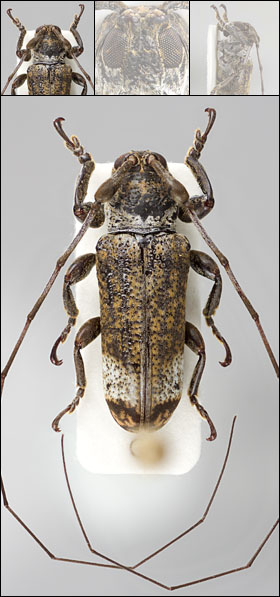 |
 Previous Genus Next Genus Previous Genus Next Genus 
Genus: Cylicasta
Diagnostic Features
- Description: Elongate-oblong, small to moderate-sized, ranging from about 7–13 mm in length. Integument generally dark brown with whitish, ferrugineous, and ochraceous pubescence.
 Head with frons elongate, narrow, about as wide as width of one lower eye lobe; frons surface roughly sculptured or not. Eyes with lower lobes ovate. Genae elongate, about as tall to distinctly taller than lower eye lobes. Antennal tubercles prominent, narrowly separated, contiguous at base; tubercles not armed at apex; antennae distinctly longer than overall body length, as much as twice as long; scape clavate, about as long or shorter than antennomere IV; antennomere III sinuate or curved, shorter or longer than scape, longer than antennomere IV; antennomere XI shorter than X (females) or longer than X (males). Pronotum shape variable, from transverse to elongate, cylindrical to conical, wider at base, without lateral tubercles. Elytra with sides roughly parallel; elytral apices individually rounded; apical 1/3 of elytra with distinct maculae; base of elytra without prominent tubercles or with two small tubercles at humeri. Basal 1/3 of elytra with dense punctation, surface coarsely punctate to granulate-punctate. Procoxae simple, without projection. Mesosternal process with apex subtruncate to feebly emarginate. Metafemora moderate in length, about 1/3 as long as elytra. Head with frons elongate, narrow, about as wide as width of one lower eye lobe; frons surface roughly sculptured or not. Eyes with lower lobes ovate. Genae elongate, about as tall to distinctly taller than lower eye lobes. Antennal tubercles prominent, narrowly separated, contiguous at base; tubercles not armed at apex; antennae distinctly longer than overall body length, as much as twice as long; scape clavate, about as long or shorter than antennomere IV; antennomere III sinuate or curved, shorter or longer than scape, longer than antennomere IV; antennomere XI shorter than X (females) or longer than X (males). Pronotum shape variable, from transverse to elongate, cylindrical to conical, wider at base, without lateral tubercles. Elytra with sides roughly parallel; elytral apices individually rounded; apical 1/3 of elytra with distinct maculae; base of elytra without prominent tubercles or with two small tubercles at humeri. Basal 1/3 of elytra with dense punctation, surface coarsely punctate to granulate-punctate. Procoxae simple, without projection. Mesosternal process with apex subtruncate to feebly emarginate. Metafemora moderate in length, about 1/3 as long as elytra.
- The combination of the following characters will help to distinguish this genus: antennae distinctly longer than overall body length, as much as twice as long; antennal tubercles narrowly separated, contiguous at base; and elytra with sides roughly parallel.
- Similar genus/genera: strongly resembles Pericasta and superficially resembles Leus.
Geographic Distribution
- Central America (Costa Rica, Nicaragua, Panama)
- South America (Argentina, Bolivia, Brazil, Colombia, Ecuador, French Guiana, Peru, Venezuela)
Host Plants/Trees
- Moraceae (Brosimum parinarioides)
Girdling Behavior
Notes
Generic Synonymies
- The type species of this genus was originally described in the genus Trestonia.
Selected References
|
 |
 
Cylicasta liturata
♂ specimen
© E.H. Nearns
|
© 2011-2015 Nearns, E.H., Lord, N.P., and K.B. Miller
The University of New Mexico and Center for Plant Health Science and Technology, USDA, APHIS, PPQ.
|


